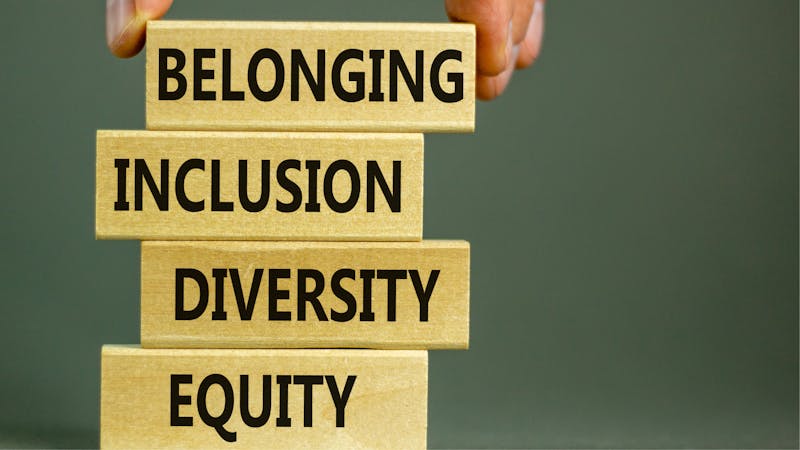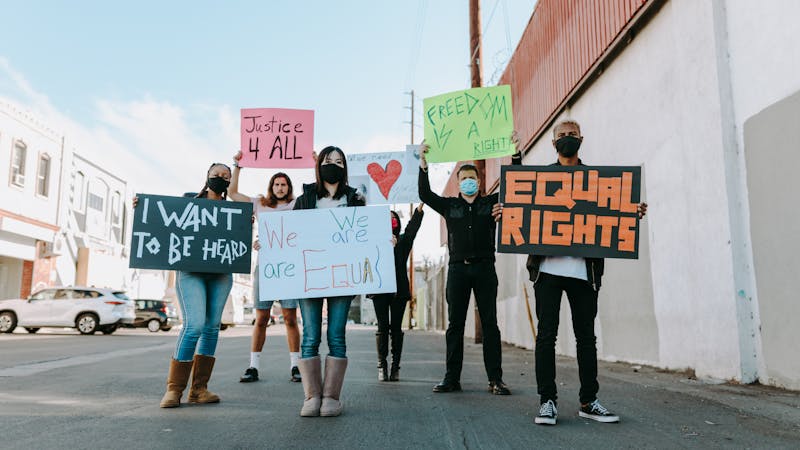Unmasking Microaggressions Educational Guide to Promoting Inclusive Conversations (DEI)

You might have seen the term microaggressions pop up on social media platforms over the last decade or so. While many use this term for any form of small aggression, when unmasking microaggressions, you'll see they are usually linked to unconscious or implicit bias.
These biases or judgments are often automatic, like autopilot. However, they can influence our behavior and how we view certain people or places - making us think it's acceptable to make subtle but inappropriate jokes or comments because "Everyone does it," or "It's a joke." While we may or may not be aware of these actions, it's important to understand the effect of microaggressions and how they harm those who continuously have to deal with them.
This educational guide will teach you about inclusive terms and unmask microaggressions. We’ll also give some suggestions on how to address them in different sectors and provide a list of supportive resources to ensure your inclusive practices are current and promote DEI (Diversity, Equality, and Inclusion).
Let's unmask some common microaggressions.
Unmasking Microaggressions: The Basics
Before proudly waving the DEI flag, you have to understand the theory behind why it's so important.
Did you know that the term microaggressions was actually coined in the '70s by Harvard University professor Chester Pierce? Under Pierce's definition, it was used to describe the subtle but constant ways black people experienced discrimination from white people. Since then, scholars specializing in inequality, inclusion, and diversity, and many who experience microaggressions daily, have said "microaggressions'' isn't a good enough description and often prefer the term "exclusionary behaviors." These subtle acts of exclusion or SAEs are designed to exclude people, pushing them further away towards the margins.
Most importantly, microaggressions can happen anywhere. They aren’t limited to one particular place.
Many also agree that there are subcategories of microaggressions or SAEs.
Microassaults
Conscious and intentional discrimination. Such as using racial slurs, displaying racially harmful symbols, and promoting racial segregation, such as preventing children from dating outside of their race.
Microinvalidations
Microinvalidations subtly negate someone else's experiences, exclude them, invalidate their thoughts, and create an environment where marginalized or underrepresented people feel unheard. Dismissing a microaggression is a microinvalidation by saying, "It was just a joke." Another example of microinvalidation is colorblindness and pretending not to see how someone's race, ethnicity, or identity can affect their experiences and challenges.
Microinsults
Microinsults can be nonverbal and verbal. Often subtle, rude comments or reactions about someone's identity and background. These can be extremely harmful but are less obvious than overt insults, so victims might feel blindsided and unsure of whether it's a microaggression or not. One example of a microinsult could be insinuating someone got a raise because the company needed to fill its inclusion quota or telling someone they are "Articulate for someone with their background."
Common Microaggressions You Might Not Assume Are Harmful
Microaggressions are often widely accepted and upheld by society. Let that sink in for a moment because this is what makes them so harmful and, unfortunately, normalized.
Microaggressions perpetuate stereotypes, reinforce systemic discrimination, and create an environment where individuals from marginalized groups continuously feel devalued and excluded. Here are some common examples. Read through them and think about whether you've heard or said any of them before.
- Backhand comments about someone's race, ethnicity, and identity, such as "You don't look (insert nationality)," "You must be good at…because you're from (XYZ.), or I'm surprised you got this done because you're all (XYZ.). Any comment that upholds stereotypes or puts down someone else from a similar group is normally a microaggression.
- Minimizing someone's experiences by telling them to "Stop being so sensitive."
- Invading someone's personal space or touching them without consent. It's like asking a person with afro-textured hair if you can touch it.
- Asking someone where they are "Really from" when asking about their heritage.
- Saying, "I am not racist; I have several….(insert reason here) friends/family members, etc.
- "I don't see color," or "There is only one race, the human race - harmful because you're dismissing a person's race, experience, and identity.
- Assuming economic status based on race or ethnicity.
- Stereotypical questions and asking individuals to speak for entire groups of people, for example, "What do all [insert group] people think about this?"
- Denying individuality and treating someone as a representative (without their permission) of their entire group.
- Assuming certain people can't hold a high position at work based on their appearance or other superficial factors. I.e., "Can I see your manager?"
- Refusing to learn how to pronounce someone's name or saying aloud, "I don't know how to pronounce those names." Instead, you can ask that individual.
- Is your period coming?
- You're too pretty to be…(XYZ)
- Any comment about mental health conditions that contribute to stereotypes and promote a culture of insensitivity, like "She's so bipolar."
- Solely basing hiring choices on age.
- Calling older adults "Adorable" or suggesting they are "Out of touch."
Navigating & Addressing Microaggressions Head-on to Promote Diversity, Equity, and Inclusion
Unmasking harmful microaggressions and promoting inclusive conversations starts with education - that's why employees, schools, and organizations have to shut microaggressions down as soon as they're reported to promote safe and inclusive conversations and communities.
Let's explore different contexts where microaggressions commonly happen and some ideas for addressing them. Remember, microaggressions are often because of implicit bias, so you've got to go deep to make any real difference. Scratching the surface just won't do.
Just a quick note: While we have tried to make this as detailed as possible, what we cover in this educational guide isn't exhaustive. So, we strongly advise doing your own thorough research using the recommended supportive resources below.
Microaggressions at School & College
- Racial Stereotyping: Teachers and peers assuming that students of a particular race excel or struggle in certain subjects based on stereotypes.
- Gender Bias: Expecting boys to be more assertive in class discussions and girls to be quieter and less assertive.
- Religious Microaggressions: Making insensitive comments about a student's religious practices or clothing.
- Making Assumptions: Making ANY assumptions about students because of abilities, race, gender, or identity.
- Failing to Address Microaggressions: It is a microaggression to ignore student-on-student microinsults, assaults, or invalidations.
Suggestions for Addressing Microaggressions in Education
- Teach students about microaggressions, challenge their implicit biases, and adopt a zero-tolerance policy.
- Do not make assumptions; remain curious and ask questions.
- When discussing historical moments or sensitive topics like immigration or traumatic events, do not make assumptions or give insensitive opinions; stick to the facts, as you don't always know the experiences of people in your class.
- Establish a safe environment for everyone in your classes from day one. Creating a safe learning environment is important for everyone to feel comfortable, safe, and understood.
Microaggressions at Work
Gender Pay Gap: Pay disparities between men and women in the same job roles.
Ageism: Discriminatory remarks or exclusion of older employees due to perceived technological or cultural differences.
Cultural Insensitivity: Colleagues joking about another's cultural background or using racially insensitive language.
Addressing Microaggressions in the Workplace
- Adopt a zero-tolerance response to microinsults at work.
- Organize monthly training to build tolerance and educate employees on different issues.
- Develop inclusive language guidelines for the welcome package or refer new employees to relevant resources.
- Review hiring processes, policies, and procedures to ensure they are inclusive and free from bias. Consider Partnering with external organizations to bring in fresh perspectives.
- Get leadership involved. Company culture trickles down, so they should be well-equipped to handle microaggressions and be supportive of promoting inclusive conversations themselves.
Navigating Microaggressions in Healthcare and Medical Settings
- Language Barriers: Healthcare providers making assumptions about a patient's language proficiency or dismissing their concerns due to language differences. Equally assuming a healthcare provider isn’t able to do their job because of their race, identity, ethnicity, age, or other.
- Cultural Insensitivity: Insensitive comments or behaviors by medical staff or patients that disregard a person's cultural or religious beliefs.
- Mental Health Stigma: Medical professionals dismissing mental health concerns as insignificant or attributing them to other factors.
Addressing Microaggressions in Healthcare
- Training and education courses need to be inclusive from day one.
- Promote diversity in healthcare teams.
- Provide a space for patients and professionals to report microaggressions.
- Offer ongoing inclusive training.
Resources and Support
Want to find out more? Explore this list of handouts, podcasts, and reading materials from the experts.
Microaggressions on Tumblr
A visual blog confronting everyday microaggressions to show "It is a big deal."
https://www.microaggressions.com/
Raising Equality Podcast
Exploring social issues, including antiracism, microaggressions, and diversity in the workplace.
https://raisingequity.org/the-podcast/
Twelve tips for responding to microaggressions and overt discrimination
When the patient offends the learner, Daniel J. Wheeler, Josué Zapata, Denise Davis & Calvin Chou.
Scenarios and solutions for medical staff to navigate microaggressions in the medical workplace.
Microaggressions: a guide - University of Bristol
Resource handout for understanding microaggressions, what they are, and how they manifest.
https://www.bristol.ac.uk/media-library/sites/equality/documents/microaggressions-guide.pdf
How Microaggressions Affect Children
A Parent's Guide on Race & Racism | PBS KIDS for Parents
Educational video for parents, guardians, and teachers on making classrooms more inclusive.
https://www.youtube.com/watch?v=6tfO10Okjmg
Teenagers Discuss Microaggressions and Racism
Educational video for students and adults talking about different experiences of microaggressions.
https://www.youtube.com/watch?v=8RfwnibEd3A
Anna Freud - Microaggressions: staff meeting presentation and guidance
A presentation and guidance on delivering a presentation about microaggressions to employees and staff members.
Let’s Not Do That Podcast
Student-led podcast by students at the University of Wisconsin Green Bay exploring microaggressions on college campuses.
https://www.uwgb.edu/podcasts/shows/let-s-not-do-that/
Subtle Acts of Exclusion by Tiffany Jana and Michael Baran
An actionable book containing sample scripts, action plans, and tools to help readers prevent subtle acts of aggression in various settings.
Resources
- 21 Racial Microaggressions You Hear On A Daily Basis by Heben Nigatu
https://www.buzzfeed.com/hnigatu/racial-microagressions-you-hear-on-a-daily-basis - What to know about microaggressions - Jacquelyn Johnson, PsyD. — By Anna Smith Haghighn
https://www.medicalnewstoday.com/articles/microagressions - Microaggressions Project on Tumbler
https://www.microaggressions.com/ - Implicit Bias, Microaggressions, and Stereotypes Resources by NEA Center for Social Justice
https://www.nea.org/resource-library/implicit-bias-microaggressions-and-stereotypes-resources

About the author
Sarah Perowne
Sarah Perowne is a language and education specialist with over 10 years of experience in teaching and content creation. She has worked with students of all ages in various teaching methods, including those with disabilities and ASD. She sports an acute knowledge and skillset in teaching English as a second/foreign language (ESL) English Language Arts and creating content for online teaching resources, articles, and podcasts.


